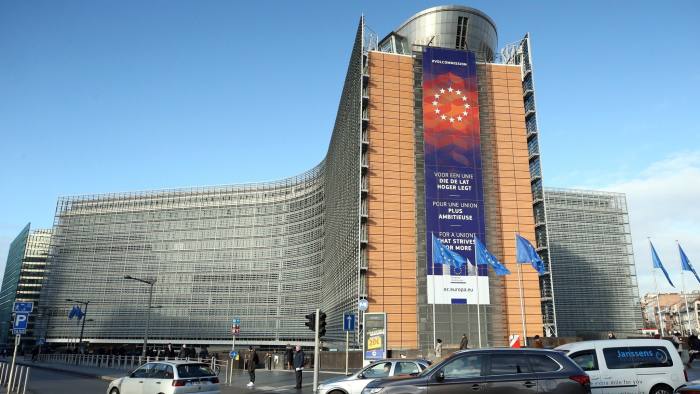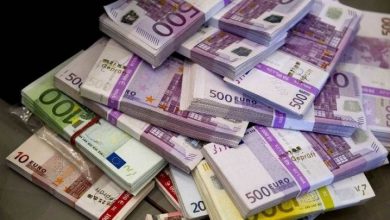The European economy has not experienced such serious problems
The next two years will be very difficult
European economies are either on the verge of a recession, or are preparing to enter it. Ifo, a German research institute that regularly conducts surveys of managers, has recorded the highest level of pessimism since 2001. The French National Institute for Statistics and Economic Research (INSEE) marks the largest drop in entrepreneurial activity since 1991. The PMI for the eurozone has fallen to its lowest level since 2001. The statistical organization Eurostat shows a drop in industrial production over the past 12 months: in Germany – by 2.4%, in France – by 2.8%, in Italy – by 3.1%.
“Economic growth in Europe since mid-2005 has been driven by investment. Costs of construction and machinery grew faster than consumer demand in many countries – this contrasts sharply with previous periods of growth. On the one hand, the positive effect of employment growth somewhat offset the negative impact of nominal wage increases, and on the other, moderate inflation amid falling prices for imported goods from developing countries protected real income. The first signal of a slowdown in August 2007 was a decline in consumer demand. Rising commodity prices accelerated inflation, which hit citizens’ purchasing power. The fall in housing markets in the UK, Ireland, Spain and Denmark has added negativity and dropped consumption in most countries ”- this is how the situation in the European economy is assessed in a report by Standard & Poors.
The reduction in production in Europe was to some extent provoked by the policy of the European Central Bank. If the US Federal Reserve System reduced the refinancing rate from 5.25 to 1.5% over the past year, the ECB has kept it at about 4% since the summer of 2007, raising it to 4.25 at the end of summer 2008 and lowering it in September to 3.75%. According to experts from Standard & Poors, until the end of 2009, the refinancing rate in the eurozone is unlikely to fall below 3.25% – so the ECB is struggling with possible inflation. Expensive credit reduces the competitiveness of European companies.
Apparently, a fairly long period of economic difficulties awaits European countries. According to the IMF forecast, in 2009 the growth in the euro area will be only 0.2%, and in the largest economies there will be a recession, at least a technical one. It is not surprising that the euro against the dollar since the beginning of September has fallen by 13% – from 1.46 to 1.29 dollars per euro.
According to forecasts, the recession in the largest European economies will peak only in the spring-summer of 2009. And this means that unemployment could rise until early 2010. In addition, the situation in Europe will be negatively affected by the fact that the US and Japanese economies are also moving along a similar path.
Suffer harder than others
So far, from large European countries, only the British government has officially recognized that a full-blown crisis awaits the country. Speaking at the end of October in Parliament, British Prime Minister Gordon Brown said that now, in addition to solving the problems of the financial market, the authorities have to prevent the dangers facing the recession.
And just a few days before the prime minister’s announcement of the first sixteen-year recession, Bank of England Chairman Mervyn King spoke. According to the country’s chief banker, the British banking system in the beginning of October was in the most serious crisis since the First World War. The worsening economic situation in Britain has already affected the national currency: since the beginning of the year, the pound has fallen in price against the dollar by 19% – from $ 2 per pound to 1.62.
“The British economy will suffer harder than other developed economies because the most unstable imbalances have formed in it. Both consumer spending and business investment, especially real estate investment, will be hit hard. In order to prevent a recession, foreign trade will not be enough. We predict that in 2009 the country’s GDP may decline by 0.9 percent, ”Simon Kerby, an economist at the National Institute for Social and Economic Research, told Expert.
Some analysts are even more pessimistic. So, Ernst & Young in 2009 expects a decline of 1–1.2% of GDP, and according to the pessimistic scenario of Capital Economics, even to 1.5%. This means a reduction in the country’s GDP by 28-40 billion dollars, which is equivalent to the entire economy of Latvia or Uruguay.
On London streets, signs of economic hardship are visible to the naked eye. In store windows both on democratic Oxford Street and on fashionable Bond Street, there is an advertisement reporting discounts of 50, 70 and even 80%. At the same time, the stores are unexpectedly empty, although the Christmas illumination already hung on the main streets is reminiscent of the approach of Christmas. Dog-walkers unexpectedly disappeared from London parks (dog walkers, previously characteristic characters with a dozen completely different and mixed dogs on a leash at the same time). Wealthy dog owners can no longer afford to pay 50-60 pounds per week to special people and now they walk with dogs themselves.
Unemployment in Britain in August 2008 rose to 5.7% of the working population. According to economists, as early as the end of 2009, unemployment could rise to 7%. And if earlier, in the first place, jobs were reduced in industry, but this time the service sector is affected the most – the financial sector, catering and retail. In London, tens of thousands of jobs in the financial sector could fall. According to the Center for Economic and Business Research (CBER), by the end of 2009, the financial sector could reduce up to 62 thousand of the nearly 400 thousand jobs that existed at the beginning of this year. Mass layoffs in the City of London have led to the fact that today 500 thousand square meters of unoccupied offices stand idle on the market. But the reductions concern not only the City; very quickly, jobs are liquidated in restaurants, bars, shops and on construction sites.
Rising unemployment, declining car sales, declining industrial production, falling real estate prices and rising inflation all confirm that the British economy is already in recession. In September, consumer prices in the country grew by 5.2% (year on year), faster than expected according to forecasts. Rising unemployment leads the British to change their economic behavior, reducing consumption and increasing savings. Over the years of the economic boom, the British have accumulated 2.56 trillion dollars of debt (minus mortgages) and today owe an average of 180% of their annual income. A third of consumer debt in all of Europe falls on the British.
“Today, many are losing jobs and even their homes, and businesses go bankrupt one by one. But, most importantly, Britain was in a state of hangover after a long “party” of the consumer boom, which was gaining momentum due to those people who could not spend a lot if they did not have access to loans, ”the Expert told Chris Tapp, economist at Credit Action, a consumer group that provides advice on debt optimization.
British consumers are abandoning more expensive goods and services, which are used to over the years of economic prosperity. It would seem that yesterday, expensive organic food grown without mechanization and chemicals was considered simply necessary for a healthy diet, and supermarkets actively advertised it. Instead of the old sandwiches in London, new healthy fast-food chains have opened, where lunch can easily cost $ 15–20. The British also abandoned the traditional holidays in the country and began to fly on vacation to Europe. All new electronic devices were immediately bought – if there were several credit cards at once, it was not difficult to do.
And today, consumers refuse expensive brands, choosing goods and services easier. Supermarkets Waitrose and Marks & Spencer, which sell expensive food, have experienced a sharp decline in sales. And the Tesco chain, like ten years ago, began to position itself as a supermarket at affordable prices. The “stars” of 2008 retail in Britain were the German chains Liddl and Aldi, which operate according to the scheme of discount stores selling the simplest and cheapest food products.
Consumers are actively reviewing budget expenditures, evaluating where they can save. Some refuse membership in sports and social clubs. Others replace lamps and electrical appliances with energy-saving ones. Still others stop buying clothes and instead take old things to the atelier and exchange bored clothes with friends. Some refuse a car, taking a metro or bicycle.
According to the British Retail Consortium (BRC), in September 2008, total retail sales fell 0.4%. In some shopping complexes, the turnover decreased by 12-14%. Analysts predict sluggish sales before Christmas and practically “dead” February – April.
All over Europe
A similar picture is observed in many other European countries. France and Italy have not yet entered a recession, but are very close to that. For several years now, Italy’s economy has been stagnating, but may be in full recession in early 2009. In August, retail sales in Italy fell 1.3%. In France, the decline was 2.4%. Unemployment is growing rapidly in both countries as companies are actively cutting costs by firing employees.
In Spain, retail sales fell 7.5% in August, the sixth consecutive monthly drop. Sales of home goods decreased by 15.8%. And even less food products are sold today – in August, sales fell by 3.8%. The end of the real estate boom in Spain has led to the reduction of tens of thousands of jobs in the construction sector. Unemployment in Spain has been growing since April, and analysts expect that by the end of 2009 it can reach a very high level by European standards – 15%.
The Irish economy has been in a recession since the second quarter, when GDP fell by 0.5% compared with January-March (then the decline was 0.3%). Household consumption decreased by 1.4% compared with the previous year, which was the first reduction since 1998. Back in 2007, consumption grew by 6%. And although exports from Ireland continue to grow in order to maintain economic growth, it is not enough.
German slowdown
The economy of Germany, the largest in Europe, is experiencing serious problems today. In mid-October, leading German economic institutions published a disappointing forecast: in 2009, the country’s GDP growth will not exceed 0.2%. “An increase of 0.2 percent per year in fact will still mean a recession, because it is comparable to a decline over two quarters. The forecast of DB Research generally indicates zero growth with significant market concern and serious risk of a negative indicator for the year, ”Stefan Schneider, an analyst with Deutsche Bank Research, told Expert.
One of the main reasons for this situation is the deterioration of the global situation, which seriously affects German exports, the backbone of the German economy. “World trade growth will decline in 2009 to three to four percent. Of course, this will affect German exports. According to our September forecasts, German export growth will be 1.5 percent in 2009. Compare with 7.5 percent in 2007. This will be a serious reduction. The German economy will no longer be able to grow thanks to external demand, as before, ”said Christoph Römer, an analyst with the Institute of German Economics (IW), to the Expert.
According to forecasts by DB Research, next year German industrial production will decrease by 2.5% (this year it grew by 1, last year – by 6.5%). The only industries that will show a five percent increase this year will be electronics (only because electronics in Germany always follow the trends of growth or decline) and engineering (because it has room to fall from 9.4% of last year’s growth) . Other sectors in 2008 demonstrate stagnation and even a drop in production. So, the production of artificial materials froze in place, and the volume of production of the chemical industry in Germany fell by 1%. Automobile production fell by 2%, textiles – also by 2, and clothes – by 20%.
The most painful German economy is experiencing a decline in production in the automotive industry, which has traditionally been the pride of the Germans and the engine of the economy. Daimler, BMW, Volkswagen have already announced the reduction in production volumes and the partial dismissal of employees. Following the automotive industry, parts suppliers are cutting back, especially those who depend not only on European consumers. Thus, Schuette, which produces up to 80% of the spark plug machines used in the world, announced a 25% reduction in demand for its products. “The times of sensational success, when one production record followed another, are long gone,” said Manfred Wittgenstein, president of the German Engineering Union.
According to the German weekly magazine WirtschaftsWoche, nearly half of the DAX list participants – 14 out of 30 concerns – plan for staff reductions. Only five of the 30 largest German concerns included in the DAX index (Adidas, Deutsche Bank, Fresenius Medical Care, K + S and Siemens) plan to hire new employees in the coming year, while Deutsche Bank will simultaneously conduct staff reductions in the investment banking division.
Germany’s neighbor Switzerland is also experiencing serious economic problems. Since the beginning of the year, the Swiss stock index SMI has lost a third of its value, and only in September-October it experienced a fall from almost 7,000 to 5,265 points.
As in Germany, it is hard for export-oriented enterprises. So, Oerlikon, one of the largest Swiss high-tech engineering companies, has already announced a decrease in turnover by 7.4%. The volume of Oerlikon orders, according to the company, decreased by almost 17%.
The banking sector of Switzerland is going through hard times. Earlier this month, the government was forced to provide multibillion-dollar assistance to UBS, which incurred more than $ 60 billion in losses in the course of speculation in the real estate market. The government provided the bank with $ 5 billion in assistance and guaranteed its debts of $ 54 billion.
Things are no better in Austria, which is in the economic shadow of Germany. The Bank of Austria business activity index fell to 46 points in September, the lowest figure in 80 months. Last week in Austria there was also the first attempt to storm an investment company by disappointed investors: AvW investment company refused to accept its certificates for payment, and investors besieged the building of its headquarters.
Eastern recession
The recession in Western European economies is inevitably reflected in the countries of Eastern Europe. First of all, the situation in eastern Europe depends on the dynamics of the German economy, experts say. “Germany’s GDP is not just 27 percent of the total GDP of the eurozone countries and 20 percent of the GDP of the EU countries. To Germany goes 26 percent of Polish exports, 28 percent of Hungarian, 31 percent of Czech. So if the German market and the West European market as a whole slow down, this will certainly affect the economies of Eastern Europe, ”warns Christoph Römer from the Institute of German Economics.
The problems of Eastern Europe are compounded by the Austrian crisis. Austria, traditionally an extremely important investor in Eastern European markets, is now hastily withdrawing money invested there. “A significant outflow of capital and a reduction in investment opportunities, caused by rising cost of loans and fear of recession, are very real. The dynamics of all East European exchanges shows that investors are very nervous – as a result, we have an outflow of capital. For example, the Austrian concern Voestalpine has already announced that it is temporarily abandoning the construction of a steel plant in Romania, ”Steven Arons, Eastern Europe specialist, managing editor of Finance Emerging Europe magazine, told Expert.
Problems with production in Romania are experienced not only by the Austrian Voestalpine. The global steel producer Mittal Steel is also cutting back on production here. The Slovak economy is experiencing similar difficulties, where the volume of car production is reduced by the French Citroёn and German Volkswagen. In the Czech Republic, production volumes were reduced by Skoda, the VW subsidiary.
On the whole, the Eastern European economies were struck by the same disease. Relatively cheap loans and the massive arrival of Western investors created the illusion of endless growth. At the same time, wage growth in these countries (for example, in Romania over the past year, wages increased by 24%) significantly outstripped labor productivity growth, and local currency rates against the euro were constantly strengthening, which gradually made the placement of production there unprofitable. But the very first signs of a global crisis forced Western investors to seriously think about the prospects for further stay in countries – new members of the European Union.
Since the beginning of the year, market indices in Poland, the Czech Republic and Romania have fallen by half. The currencies of Eastern European countries, yesterday experiencing growth against the euro, which pleased local residents and upset Western companies invested in local factories, began to sharply lose value. “For many countries of Eastern Europe, the weakening of national currencies has become a serious problem, because in the past years of the economic boom, many loans in foreign currencies were taken in these countries,” says Stephen Arons of Finance Emergine Europe.
More recently, economists had hoped that a slowdown in western Europe could be offset by growth in the east, but these forecasts did not materialize. Although Poland and Slovakia continue to grow, the financial and economic crises in Hungary and the Baltic countries raised the question of their future.
Estonia and Latvia, until recently known as the “Baltic tigers,” have been in a state of recession since the spring of 2008. “A long period of rapid growth was paid for by cheap and affordable loans from abroad, mainly from Scandinavia. When liquidity has dried up, economic growth in these countries has run out. Local consumers were among the first in Europe to face a sharp increase in the cost of lending and the need to cut costs, ”Neil Schering from Capital Economics told Expert. As a result, in 2009 Latvia’s GDP will decrease by 0.9%, Estonia – by 1.5%.
This post is also available in:
 English
English  Русский (Russian)
Русский (Russian)






